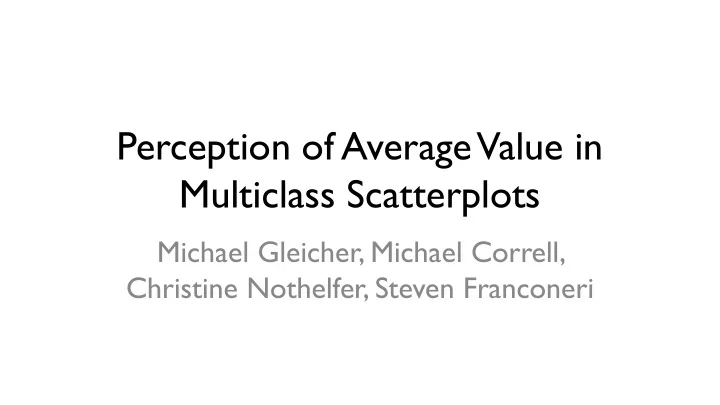

Perception of Average Value in Multiclass Scatterplots Michael Gleicher, Michael Correll, Christine Nothelfer, Steven Franconeri
Perception of Average Value in Multiclass Scatterplots Michael Gleicher, Michael Correll , Christine Nothelfer, Steven Franconeri
Perception of Average Value in Multiclass Scatterplots Michael Gleicher, Michael Correll , Christine Nothelfer, Steven Franconeri
Which color is higher on average?
Which color is higher on average?
Which color is higher on average?
Which color is higher on average?
Which color is higher on average?
Which color is higher on average?
Summary How well can a general audience do this task? How do design choices affect performance?
Visual Aggregation
Why?
Why?
Why?
Why?
Why?
Why?
Anscombe’s Quartet 15 15 10 10 5 5 0 0 0 5 10 15 0 5 10 15 15 15 10 10 5 5 0 0 0 5 10 15 0 10 20
Premises
Premises
Premises
How Well Can We Aggregate?
Perception of Aggregates
Perception of Aggregates
Methodologies
Methods 11 between-subjects experiments 9 within-subjects experiments 600 participants (17,520 trials)
Results
Results
Visual variables
>
Color is a stronger cue than shape > 79% 72%
Results
Irrelevant Cues
≈
≈ 77% 80%
Distractor class
≈
≈ 78% 77%
Distractor class and irrelevant cue
>
> 80% 76%
Averaging is robust to visual complexity
Averaging is robust to visual complexity
Averaging is robust to visual complexity
Averaging is robust to visual complexity
Results
Redundant cues
≈
≈ 81% 80%
Ongoing Work
Ongoing Work
Ongoing Work 100 100 80 80 60 60 40 40 20 20 0 0
Ongoing Work 100 100 80 80 60 60 40 40 20 20 0 0
Conclusion
Acknowledgments This work was supported in part by NSF awards CMMI-0941013, BCS-1056730, SBE-1041707, DRL-0918409, DRL-1247262, and IIS-1162037 and NIH award R01 AU974787. Visit http://graphics.cs.wisc.edu/Vis/ScatterVis13/ for data tables, stimuli, and sample experiments.
Extra Slides
Eye Tracking Means 16 pixels apart Means 80 pixels apart
Shape is a weaker cue than color
Shape is a weaker cue than color 72.9% accuracy overall 79.4% accuracy overall
Shape is a weaker cue than color 75% accuracy at 26.1 pixels apart 75% accuracy at 19.7 pixels apart
Color vs. Shape
Redundancy
Δ parameter Δ =16 pixels Δ =80 pixels
Δ parameter Δ =16 pixels Δ =80 pixels
Δ parameter Δ =12 pixels Δ =80 pixels
Shape is a weaker cue than color * 1 79.4% 0.8 72.9% Accuracy 0.6 0.4 0.2 0
Averaging is robust to visual complexity
Averaging is robust to visual complexity 1 80.1% 76.9% 0.8 Accuracy 0.6 0.4 0.2 0
Averaging is robust to visual complexity
Averaging is robust to visual complexity 1 78.2% 76.9% 0.8 Accuracy 0.6 0.4 0.2 0
Averaging is robust to visual complexity 1 80.1% 78.2% 76.9% 76.9% 0.8 Accuracy 0.6 0.4 0.2 0
Visual complexity still matters
Visual complexity still matters * 1 79.5% 75.5% 0.8 Accuracy 0.6 0.4 0.2 0
Visual complexity still matters * 1 80.1% 79.5% 78.2% 76.9% 76.9% 75.5% 0.8 Accuracy 0.6 0.4 0.2 0
Redundant encodings don’t help
Redundant encodings don’t (always) help 1 80.7% 79.7% 0.8 Accuracy 0.6 0.4 0.2 0
Redundant encodings don’t (always) help
Recommend
More recommend